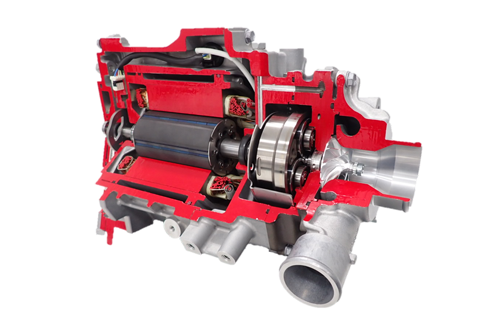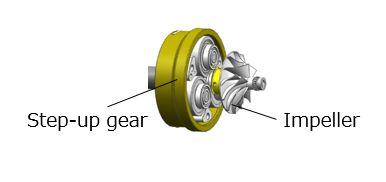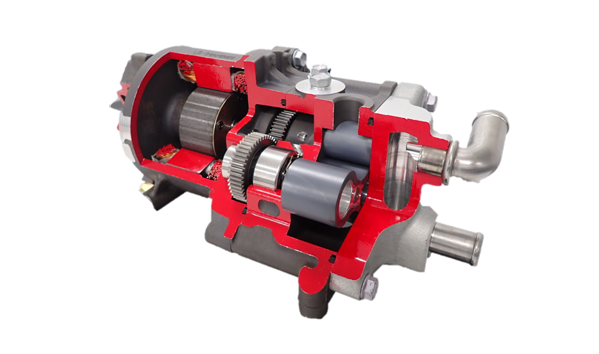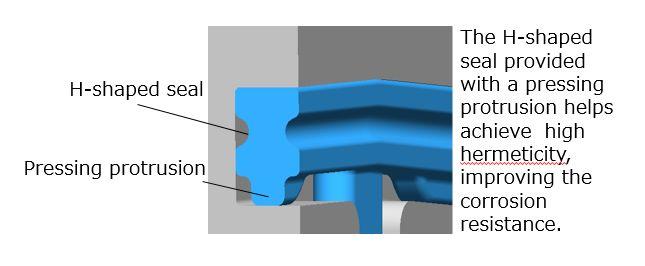News Releases
Toyota Industries Develops New FC Air Compressor and Hydrogen Circulation Pump, Now Installed in the New Toyota Mirai FCEV
[Translation]
Toyota Industries Corporation (President: Akira Onishi) has developed a new air compressor and hydrogen circulation pump for fuel cells. These products are installed in the new Mirai FCEV announced by Toyota Motor Corporation on December 9.
Climate change is the most important issue the nations of the world are addressing. The Japanese government has also established a goal of realizing a carbon-free society by 2050. Against this backdrop, expectations are heightening further for FCEVs, considered the ultimate eco-cars because they use hydrogen as fuel and emit only water during operation. The use of hydrogen is also increasing in many other areas, including commercial use of FC systems.
The new Mirai was developed in anticipation of the wide-spread adoption of FCEVs and boasts an extended cruising range. Its styling and driving performance were also comprehensively reengineered, with the goal of receiving customer responses like, "I chose the Mirai because I simply wanted this kind of car." Toyota Industries' products are also contributing to the concept of the Mirai being an ideal car, by providing efficiency improvements and reductions in size and weight, etc.
The newly developed air compressor achieves a 24% compression efficiency improvement, 35% weight reduction, and 45% size reduction compared to the previous model. This was accomplished through adoption of a centrifugal method that uses a movable roller-type step-up gear, the first of its kind to be used in a mass-produced product in the world*. Additionally, the adoption of a new seal structure made it possible to change the material used in the hydrogen circulation pump from the previous stainless steel to aluminum, achieving a 41% weight reduction.
In addition to making products for FCEVs, Toyota Industries is also working to popularize FC technology, in a material handling equipment field, its main line of business, such as FC lift trucks and FC tow tractors. Going forward, the company plans to continue contributing toward the realization of a hydrogen society by expanding its FC-related product lineup.
The following describes the roles the newly developed products play in FCEVs and their features:
1. Roles Toyota Industries' products play in FCEVs
FCEVs use electricity generated from the reaction of hydrogen with oxygen inside the FC stack to drive the motor. Oxygen is drawn in from the atmosphere and compressed by an air compressor, then supplied to the FC stack. Hydrogen is supplied from a high-pressure hydrogen tank, which has been filled at a hydrogen station. Furthermore, any hydrogen that does not react during power generation and the water generated are drawn out from the FC stack by a hydrogen circulation pump. The hydrogen is not wasted but is sent back to the FC stack while the excess water is discharged to the outside. In this way, the air compressor and hydrogen circulation pump play important roles in the power generation system of an FCEV.

2. Air compressor
After starting, FCEVs require continuous reaction of hydrogen with oxygen inside the FC stack. Therefore, an air compressor is required to efficiently draw in and compress air over a wide range of airflow rates, i.e., from a low flow rate during idling to a high flow rate during acceleration.
Capitalizing on the compression technology it has cultivated through the development and manufacturing of car air-conditioning compressors, Toyota Industries newly changed the method used in the air-compressing part of its air compressor to a centrifugal one that uses a movable roller-type step-up gear, the first of its kind to be used in a mass-produced product in the world*. Adopting the movable roller-type step-up gear made it possible to rotate the impeller in the compressing part at an ultra-high speed (183,700 rpm), as does a turbo charger in an automobile engine, greatly contributing to the higher output of the new Mirai.
Furthermore, the movable roller inside the step-up gear moves to the optimum position in response to changes in the air flow rate, to transmit motive force from the motor to the impeller. This allows the air compressor to efficiently compress air during both low and high air flow rates, improving compression efficiency by 24% compared to the previous model and achieving a weight reduction of 35% and a size reduction of 45%.


3. Hydrogen circulation pump
The hydrogen circulation pump is required to efficiently circulate both any hydrogen that did not react during power generation and the generated water. Adopting a new seal structure improved the corrosion resistance of the newly developed hydrogen circulation pump and made it possible to switch its material from the previous stainless steel to aluminum, achieving a 41% weight reduction.


In addition to the products described above, the new Mirai also incorporates a car air-conditioning compressor and an inverter for hydrogen circulation pump, both made by Toyota Industries.
* Based on figures from research by Toyota Industries




